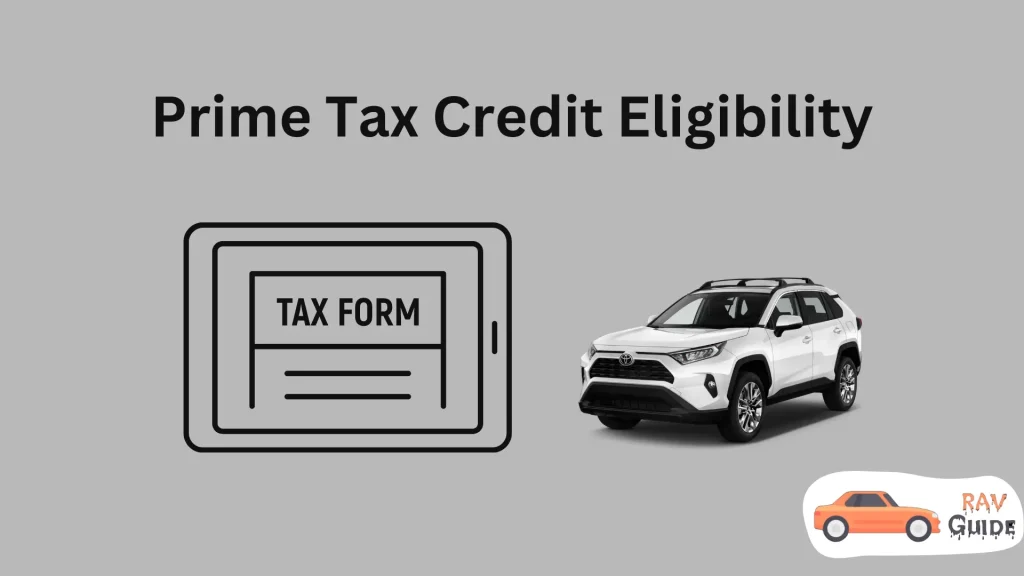Getting the most value from your electric or hybrid car is normal. With various tax rebates and bonuses in recent times, it’s essential to explore the options available to you. If you own an RAV4 Prime, you might be curious about the tax credit it offers.
Unfortunately, in 2024, the Toyota RAV4 Prime doesn’t qualify for the federal tax credit. This is because the car’s final assembly doesn’t happen in North America.
Let’s dig into the specifics of the Toyota RAV4 Prime tax credit status and touch upon some recent changes that have taken place.
What is the Federal EV Tax Credit?
Understanding the Federal EV Tax Credit is crucial when looking at electric vehicles like the RAV4 Prime. This tax credit was introduced by the U.S. government back in 2010, offering a substantial benefit of up to $7,500 for those purchasing a new electric vehicle.
Here’s how it works: when you buy an eligible electric vehicle, you get a credit of up to $7,500 against your tax liability. This credit doesn’t give you a tax refund, but it can significantly lower the amount you owe in taxes. It’s a fantastic advantage for people keen on getting an electric vehicle.
However, there are some rules to follow. Once a car manufacturer sells 200,000 electric vehicles, they reach a cap on tax credits. Both Tesla and General Motors hit this cap, preventing them from offering tax credits on their vehicles. Toyota joined this club in June 2022. Without any changes in legislation, Toyota would have phased out the tax credits by October 2023.
Although the 200,000 limit was removed in 2023, new restrictions were added to the rules (according to IRS.gov). Staying informed about these details is essential for anyone considering an electric vehicle purchase.
Qualification Status of Toyota RAV4 Prime Tax Credit
Checking the tax credit status for the Toyota RAV4 Prime is essential, especially considering recent changes. The RAV4 Prime used to qualify for a tax credit of up to $7,500, but that’s no longer true.
Here’s why: when a car manufacturer sells 200,000 qualifying vehicles, the credits start to phase out. Toyota hit this mark in June 2022, which should have made them eligible until October 2023. However, a new law came into play.
In August 2022, President Biden approved the Inflation Reduction Act, which limited federal EV tax credits to vehicles with final assembly in North America. Unfortunately, the RAV4 Prime is produced in Japanese plants, making it ineligible for the tax credit.
Let’s take a quick look at previous rebates for various Toyota models:
While Toyota models may not qualify for federal tax incentives, there’s still hope for local rebates. Many states offer incentives through local electric companies, so it’s a good idea to research your region before deciding on an electric or hybrid vehicle.
Why Toyota RAV4 Prime Doesn’t Qualify for the Federal Tax Credit?
The reason the Toyota RAV4 Prime doesn’t qualify for the federal tax credit is because of the Inflation Reduction Act. This law brought in new rules, and one of them is that vehicles must be assembled in North America to be eligible for federal rebates.
Unfortunately, the RAV4 Prime, made by Toyota, is currently manufactured in Japan, which disqualifies it from the federal tax credit.
Moreover, the rules for vehicles assembled in North America have become more specific. To be eligible for federal tax credits, certain conditions must be met:
As a positive change, in 2024, electric vehicle tax credits can be obtained directly from the dealership during the sale. Customers won’t have to wait for their income tax returns to receive the credit.
Effects of the Inflation Reduction Act on RAV4 Prime
The Inflation Reduction Act of 2022 brought significant changes to the electric vehicle scene, affecting models like the RAV4 Prime. This legislation shook things up by implementing new rules that restricted federal EV tax credits exclusively to vehicles assembled in North America.
For the RAV4 Prime, which comes from Toyota’s Japanese plants, this posed a challenge. Despite its popularity among hybrid vehicles, the RAV4 Prime lost its eligibility for the federal tax credit due to its assembly location.
Before the implementation of the legislation, the RAV4 Prime benefited from a tax credit amounting to a maximum of $7,500. However, the introduction of the new legislation led to a gradual reduction of the tax credit, ultimately resulting in its complete elimination.
The impact of the Inflation Reduction Act extended beyond just the RAV4 Prime; it affected various models from Toyota, reshaping the landscape of tax credits for hybrid and electric vehicles.
Will Toyota RAV4 Prime Qualify in the Future?
Whether the Toyota RAV4 Prime will qualify for the federal tax credit in the future is a bit uncertain, but there’s a glimmer of hope. The removal of the 200,000 vehicle production limit in 2023 opens up possibilities for Toyota, but there are still challenges.
Currently, the RAV4 Prime doesn’t qualify due to its final assembly taking place in Japan. However, Toyota has plans to build new battery manufacturing facilities in North Carolina and Michigan by 2025. This development could potentially make the RAV4 Prime eligible for the tax credit once more.
Moving the final assembly to North America is an option, but it involves a significant investment and extensive plant modifications. Even if Toyota decides to make these changes, meeting the other qualifications poses challenges. It may not be a practical move for the automaker at this time.
As of now, there’s no indication that the RAV4 Prime assembly will be shifted to North America. If there are any changes in the future, I will keep you updated.
Alternative Cars that Qualify For Credit
If the Toyota RAV4 Prime doesn’t qualify for the federal tax credit, you might be interested in exploring other options that do.
Fortunately, some fantastic vehicles still qualify for the tax credit. Here are a few:
Automobiles eligible for the complete $7,500 tax credit:
Vehicles qualifying for a partial tax credit ($3,750):
- (Source: fueleconomy.gov)
Remember, when choosing an alternative vehicle, you’ll encounter differences in features, style, reliability, and other factors. However, if you love the features and design of the RAV4 Prime, it’s still worth considering. Additionally, if you’re considering financing options, it’s important to explore reputable sources, such as a trusted money lender in Singapore, to ensure you receive reliable and trustworthy financial support.
Conclusion
In conclusion, while the RAV4 Prime currently doesn’t qualify for the federal tax credit due to its assembly location, changes in the future, such as Toyota’s plans for new battery facilities in North America, could bring potential eligibility. Prospective buyers need to stay informed about evolving policies and explore alternative vehicles that still offer tax credits, keeping in mind their preferences and priorities in choosing a hybrid or electric car.

